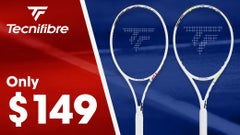Guide to Tennis Racquet & String Terms
Here is a list of terms that are used throughout our website (and a few that aren't), along with their definitions. If you have any questions or comments, please drop us a note at info@tennis-warehouse.com.
Actual Tension: The tension in a strung racquet, which will almost always be lower than the machine setting, or reference tension. This is due (mostly) to string relaxation, or creep. As a result, a racquet strung at 60 pounds may actually measure (with a Stringmeter) 50-55 pounds, depending on head size, type of string and machine type used.
Balance: Static measure of weight distribution in a racquet and measured from the butt end in inches and/or centimeters. Commonly referenced in "points" head light or head heavy - each "point" represents 1/8 inch. Generally speaking, heavier racquets are head light to maintain maneuverability, while most of today's super-light racquets are head heavy to supply enough mass (which translates into power) to the area of the frame where the ball is being contacted. A 27 inch racquet with a balance point of 12-1/2 inches is 1 inch, or 8 points head light (even balance would be 13-1/2 inches). A 28 inch racquet with a balance point of 15 inches is 1 inch (or 8 points) head heavy. Static balance ultimately affects swingweight (see below), which is a dynamic measure of racquet maneuverability.
Cross-Section: The width/diameter of a frame or string. Usually measured in millimeters. Frames - a wider cross-section frame will be stiffer than a thinner frame, all things being equal (ATBE). Strings - a thicker cross-section string will be more durable than a thinner string, ATBE.
Damping (or Dampening): Generally refers to vibration and/or shock damping. Handle systems, such as Prince's Air+ Comfort Handle, Wilson's Triad Technology with Iso.Zorb and Head's ShockStop are designed to reduce frame shock and vibration before they reach the player's hand. Weight is also effective in decreasing shock and vibration. Rubber string dampers reduce string vibration only - they have no effect on frame shock or vibration (it's simple physics - a 2 gram string damper versus a 250-350 gram racquet striking a 60 gram ball...).
Drill Flash: Debris that falls into the frame as a result of drilling the string holes. All racquet companies attempt to remove this debris during production and most racquets are drill flash-free. However, even the smallest amount of debris can cause an irritating rattle. Some racquets feature a trap door on the butt cap to allow easy removal of drill flash. Otherwise, the strings and grommets must be removed and the drill flash shaken out through the string holes.
Elasticity: Oft used term to describe a string's stretchiness and comfort. In strings, the ability of a string or web of strings to return to it's original position after ball contact. Factors that influence this include string material, construction, gauge and tension. Over time, strings lose tension and elasticity, making them play dead and requiring more effort from the player.
First Moment: Also known as "pick-up" weight. How a racquet feels when picked up by the handle end. A rough, static measure of a racquet's maneuverability based on weight and balance. The formula to calculate a racquet's first moment is weight (grams) multiplied by balance (measured from the butt end in centimeters), divided by 100. Example: 284 grams (10 ounces) X 34 centimeters (13-1/2 inches) /100 = 96.5 gram/meters.
Gauge: Standard U.S. measure of string thickness. Most tennis strings are 15-17 gauge, with a few specialty strings being 18-20 gauge. The higher the gauge number, the thinner the string and typically measured in millimeters. Half-gauges are represented by the letter L, for "light". A 15L is between a 15 and 16 gauge. Thinner strings offer greater feel, power and spin potential than a thicker string of the same material and construction. Although the Tennis Industry Association has standardized gauge specifications, don't assume that all 16 gauge strings (or 17 or 18...) are created equal. One company's 16 gauge string may measure 1.28 mm, while another will measure 1.32 mm, which represents almost a half gauge difference.
Grip Size: Standard tennis grip sizes range from 4-1/8 to 4-5/8 inches. The accepted method for measuring your grip size is to hold the handle with an Eastern forehand grip (palm on the same bevel as the strings). The optimum grip size would allow you to fit your index finger between the palm and longest finger. Player preference obviously allows for exceptions to this rule. While many "experts" suggest using the largest comfortable grip size, keep in mind it's easier to increase handle size. In fact, most of today's racquet handles cannot be reduced in size. If you're between grip sizes, go with the smaller size and add an overgrip or have the grip built up with a heat-shrink sleeve.
| US | Europe |
|---|---|
| 4 inch | L0 |
| 4 1/8 | L1 |
| 4 1/4 | L2 |
| 4 3/8 | L3 |
| 4 1/2 | L4 |
| 4 5/8 | L5 |
Head Size: Refers to size of strung area of a racquet and usually measured in square inches. A larger head size provides more power and a larger sweetspot, while a smaller headsize gives you more control, ATBE. Although no industry standard exists, the current unofficial classifications are:
| Head Size | Square Inches | Square Centimeters |
|---|---|---|
| Midsize: | 85-93 | 548 - 600 |
| Midplus: | 94-105 | 606-677 |
| Oversize (OS): | 106-115 | 678-741 |
| Super OS: | 116+ | 742+ |
Hybrid Strings: The combination of any two string types or gauges - one for the mains and one for the crosses. Kevlar hybrids are the most common, combining durable Kevlar (the stuff bulletproof vests are made from) mains with nylon crosses. Designed as a last resort for chronic string breakers. We strongly urge trying thicker nylon strings or polyester strings before switching to a Kevlar hybrid, due to its extreme stiffness and lack of power.
Maneuverability: See Swingweight.
Moment of Inertia: See Swingweight.
Nodal Point (Node): See Sweetspot.
Polar Moment of Inertia: The property that determines how stable a racquet is on off-center hits, including its resistance to twisting and the sweetspot size from side to side (3 and 9 o'clock). Also known as a racquet's "twist weight". A racquet with a larger polar moment will be more resistant to twisting on off-center hits. Racquets with wider heads will have larger polar moments of inertia. Oversize racquets generally have a larger polar moment and thus resist twisting better than their midplus counterparts. Polar moment of inertia can be increased by adding weight at 3 and 9 o'clock, using the largest comfortable grip size and replacing worn grips regularly. Keep in mind, any weight addition will also change the racquet's balance and swingweight.
Reference Tension: The tension a racquet is strung at, or machine tension, which is always higher than Actual Tension. Continuous pull machines (electric, electronic and dropweight) will generally string tighter (5-10%) than a lockout (spring tension) machine, ATBE.
Resilience: A commonly used term to describe string responsiveness. Similar to elasticity, a more resilient string is more responsive or lively, providing greater ball speed or power. Specifically, resilience is the speed at which a string (or web of strings in a strung racquet) return to their original position after contacting the ball. Over time, strings lose their resilience, returning less energy to the ball. This loss of resilience causes the strings to play "dead".
Shock (frame): Initial, high-amplitude oscillation (jarring) of the racquet during or immediately after ball contact. Often confused with frame vibration, frame shock is generally believed to contribute more to wrist, elbow and/or shoulder injuries than vibration. Generally, a smaller, stiffer, lighter racquet strung at high tension will produce more shock than a larger, flexible, lightweight frame strung loosely. Off-center hits also increase the amount of shock transmitted to the hand and arm. In fact, if you can hit the Center of Percussion (COP) area of the sweetspot each time, your shots will be shock-free. Certain handle systems (for example, Prince's Air+ Comfort Handle and Head's ShockStop) are effective in reducing shock before it reaches the hand. Additionally, Wilson's Triad Technology and Pro Kennex's Kinetic System Technology are designed to absorb frame shock. After-market methods of reducing frame shock include adding weight to the frame, lowering string tension, using a thinner gauge string and increasing grip size (to a point) to reduce torque. String vibration dampers are ineffective at reducing or absorbing frame shock.
Sweetspot: Simply put, the area of a strung racquet that provides the greatest energy return (power) and accuracy with the least amount of shock or vibration. There are actually 3 sweetspots: Sweetspot 1 is the Center of Percussion (COP) and offers the least amount of initial shock to the hand when struck. Shock is generally accepted as being potentially most harmful to player's arms. Sweetspot 2 is the Nodal Point (or Node) and produces the least amount of vibration when struck. Frame vibration is what players feel after ball contact (lingering, low-level oscillation) in certain (generally more flexible) racquets. While uncomfortable, frame vibration doesn't pose the same injury risk that frame shock does and can be effectively reduced with handle systems, such as Prince's Air+ Comfort Handle (found on their More racquet line) or Head's ShockStop Technology. Sweetspot 3 is the area of Maximum Coefficient of Restitution, or a racquet's power. It is the lowest of the 3 sweetspots. Location of sweetspot is determined by several factors, including racquet weight, balance, length, headsize and string tension.
Swingweight: Measure of how heavy a racquet feels when swung, i.e. maneuverability. Also known as Moment of Inertia or Second Moment, swingweight is dependent on several factors, including racquet weight, length, balance, head size. A heavy swingweight racquet is more powerful than a light swingweight racquet (ATBE), but will be less maneuverable. Also, a heavy swingweight racquet can be relatively light in overall weight by placing the majority of weight in the head. A trend initiated by Wilson with their Hammer racquets, the objective is to retain maneuverability without sacrificing power by distributing most of the overall weight to the upper hoop, where ball contact is made. Swingweight can be increased by adding weight above the pivot point (where the racquet is gripped) or by increasing length. Swingweight (like overall weight) cannot be reduced unless the bumper is removed or racquet length is reduced. Keep this in mind when selecting a racquet to purchase - better to error on the light side and add weight if needed.
Torque: Side-to-side twisting of a racquet during off-center hits. See also Polar Moment of Inertia.
Vibration (Frame): The lingering, low-frequency oscillation of the racquet after ball contact that players feel. Generally, more flexible racquets produce greater low-level vibration than stiffer frames. Often confused with string vibration, frame vibration has a shorter duration and cannot be reduced using small, rubberized string vibration dampers. Some handle systems are effective at reducing frame vibration. Also, hitting the Node area of the sweetspot produces the least amount of frame vibration. Post-production methods for reducing frame vibration include adding weight and stringing at mid-range. String vibration dampers will not reduce frame vibration.






